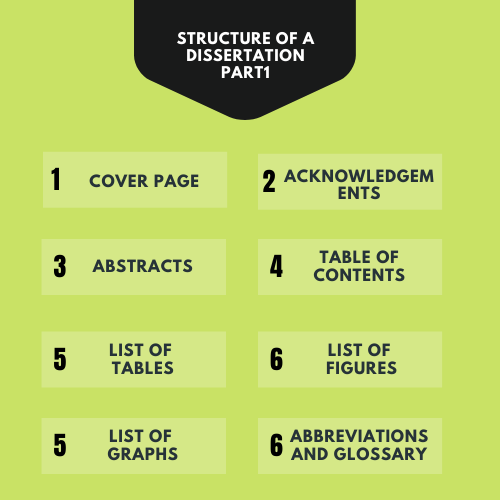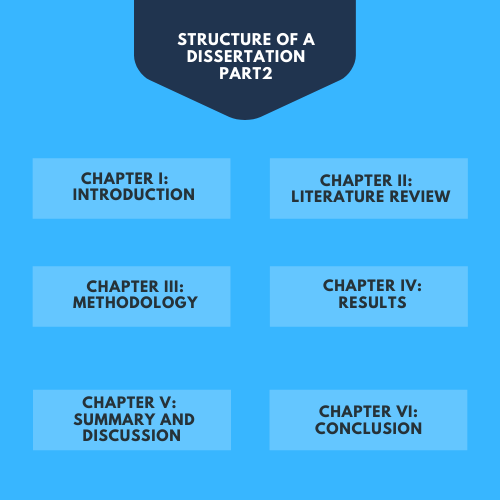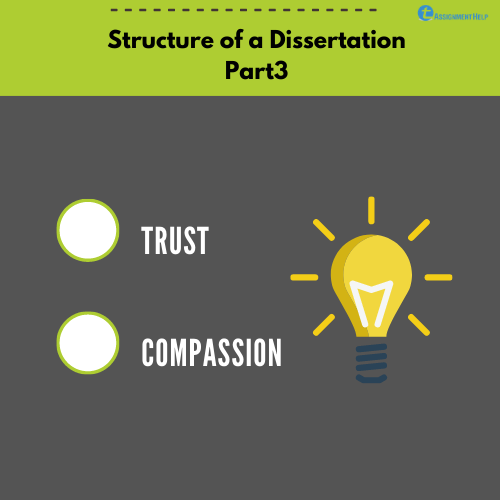Understanding The Dissertation Structure

A dissertation is one of the most important and significant pieces of academic writing in the academic life of an individual. It involves years of research, preparation, fieldwork, and gaining in-depth knowledge of a subject, in order to complete a dissertation. This is why it is important to completely understand the dissertation structure in order to include all the information effectively.
In this article, we will take you through all of the sections of a dissertation and explain the importance and contents of each of them. In order to better understand the dissertation structure, we have separated it into three 3 parts, on the basis of its contents:
Structure of a Dissertation
Part 1
- Cover Page
- Acknowledgements
- Abstracts
- Table of Contents
- List of Tables
- List of Figures
- List of Graphs
- Abbreviations and Glossary
Part 2
- Introduction
- Literature Review
- Methodology
- Results
- Summary and Discussion
- Conclusion
Part 3
- References
- Appendix
Keep reading till the end to find out about what each section of the dissertation structure entails! But let us first understand more about what a dissertation is and why it is important to pay attention to a dissertation structure.
What is a Dissertation?
A dissertation is quite a long piece of literature, which explores an academic topic in depth. It is based on the original thesis, and research which can be significant for the field. It is submitted as a part of the doctoral, master’s or bachelor’s course, in order to complete the course and get the degree certification.
Once a dissertation is approved and published, it can help future researchers to build on the information and come up with new breakthroughs. Therefore, it is important that the information presented in a dissertation is structured appropriately so that it is easy for the reader to navigate through it and understand the contents easily.
The structure of a dissertation is quite standard universally; however, depending on the field or the university, there may be slight changes in the dissertation structure. Since a dissertation, presents depth information, it can be quite lengthy and require multiple drafts and attempts to get it right. The average word count of a dissertation can be anywhere around 10,000 words, whereas the maximum word limit of a PhD thesis can even go beyond 80,000 words if you include the references, bibliography and footnotes.
It is because a dissertation is such a long and significant piece of writing, that it becomes imperative that one fully understands the dissertation structure before writing it, in order to present all the information appropriately.
Structure of a Dissertation
As mentioned earlier, the basic structure of a dissertation can be divided into three parts, wherein:
Part 1: contains all the preliminary details about the dissertation, so as to help the navigation through the text easily,
Part 2: contains, the main contents of the dissertation, that is from the introduction, till the conclusion section,
Part 3: contains all the supporting facts and details which can help the reader in understanding the contents of Part 2, such as the reference list and appendix sections.
Let us now dig deeper and understand the contents of each of the sections of a dissertation structure:
Part 1
Part 1 of the dissertation structure consists of all the sections, which will help the reader in understanding what the dissertation is about and how to navigate through it. A dissertation is all about structure and organised presentation of information. Below is a list of sections in a dissertation structure which can help the author in doing just that!
- Cover page
A cover page is the first page of the dissertation. It contains all of the necessary information such as the name of the authors, the name of the university and the department where the dissertation is being submitted, along with the main title of the dissertation. There may be some additional details or a specific format to arrange this information on your cover page, which varies from university to university. You can contact your professor, and get a template of how you should present your cover page.
- Acknowledgements
It is a section of the dissertation structure where you can, acknowledge and show gratitude towards all those who helped you or inspired you in completing your dissertation, such as your supervisors, friends, family, colleagues, God, etc. It is an optional section and is supposed to be written after completing the dissertation but is placed right after the cover page.
- Abstract
The abstract is a short summary of your whole dissertation in no more than 300 words. It is the first paragraph which discusses the dissertation, and therefore you must pay attention while writing it. It includes the main aim of the paper, along with its scope and the inferences made.
- Table of Contents
It is the section of the dissertation, which contains the page number and the location of all the section in the dissertation structure. The table of contents helps the reader to navigate to each section of the dissertation easily. It is important to follow the assigned format while formulating the table of contents so that it doesn’t cause any confusion while interpreting it.
- List of Tables
Since a dissertation is a very large academic document and contains various tables, it is important to include a list of the table where all of the tables are listed, along with their name and location.
- List of Figures
The list of tables in a dissertation structure is followed by a list of figures, for the same, as there are dissertations may involve a large number of figures and diagrams.
- List of Graphs
It is important to include a list of all the graphs used in the dissertation so that it can easily be located by the audience, whenever required.
- Abbreviations and glossary
Depending on the complexity and the contents of your dissertation, you might have used some technical words, abbreviations and jargons, which the audience might not be familiar with. Therefore, you can provide a dedicated list, where you can include all of the abbreviations and terms, along with their full forms and meaning, so that it is easier for the audience to understand the text.
Part 2
The next section begins the second part of your dissertation structure. It is the section, which contains the main details and contents of your research and its results. Therefore, it is important that you give special attention while drafting this section.
It should be noted that, in a dissertation, each of the sections contained in Part 2, are listed as chapters. Hence, you must frame your dissertation structure as chapter 1, chapter 2 and so on. You must also, list and number all of the subsections of each chapter in your dissertation so that it can be identified from the table of contents.
- Chapter I: Introduction
Chapter one of your dissertation structure should always be the introduction. It is where you provide all the introductory details about your dissertation. Establish the main topic of your research, along with its scope, background and significance. Provide an overview of your study and give some description of its scope and clearly present the research questions and objectives.
- Chapter II: Literature Review
The next section of your dissertation structure should be the review of the literature. Before you get into your main research and observations, it is important that you present all the relevant information of your study in the form of a literature review. Here you should include all the relevant academic articles and other sources, which can bridge the gap between what is already known and how your study and its results are important to the field.
- Chapter III: Methodology
The third chapter of your dissertation structure is the methodology of research. A dissertation is much more than the information you present in the final document. It involves years of research and hard work, using which you present your observations, inferences and conclusions in the dissertation.
Present an in-depth look into the framework of your research. Address your methodology, along with the various steps involved in your research. Give a description of the tools and equipment used by you or the obstacles faced. Discuss your method of analysing the observations along with a justification and reasoning as to why you pick this particular way of research and why it is the most suitable.
- Chapter IV: Results
Ensure that you keep all of the sections of your dissertation structure separate and do not mix up the contents. After writing all the details of your research methodology in the previous section, you can now move onto present the observations and results of your research.
Address each of your research questions and focus on how your research has explored it. Present a clear description of how you have come to this conclusion, with the help of tables, figures, and graphs wherever necessary. Support your results and inferences with relevant references.
- Chapter V: Summary and discussion
It is a section of the dissertation structure, which is sometimes, combined with the Results chapter. Therefore, you should clarify the dissertation structure to be followed by your PI or supervisor.
The summary and discussion section, present all of the results in one place and discusses the importance and implications of the results. The discussion section is an important part of your dissertation, as it provides you with an opportunity to present your view on how your research has proven to be successful or explore its limitations, in details, and focus on the significance of the research topic along with the future scope.
- Chapter VI: Conclusion
And the final chapter of your dissertation structure is the conclusion. A conclusion is important for the dissertation as it connects all of the contents and finding, with the main aim and research objectives. It allows you to tie up all loose ends and bring your dissertation together. Keep in mind that you must never provide any new piece of information in the conclusion section, rather simply summarise and present the implication and significance of your study.
Part 3
Once you have finished writing the conclusion, all that is left for you to do is to include the final two sections of your dissertation structure. Let us have a look at the final sections of your dissertation structure:
- References
As you know, that since a dissertation is a very long piece of writing which presents very important specialised information, it is important that all of the facts and evidence are supported with relevant citations and references.
A reference list is a place where you have to present a detailed record of all of the sources used in the dissertation, in a detailed manner, as per the assigned referencing format. Not doing so can attract plagiarism and intellectual property violation charges.
- Appendix
The final section of your dissertation structure is the appendix. It is usually an optional section, where the author can include all the information, which may or may not be required by the reader, but can help them in understanding the research more easily. The contents of the appendix should be cited and structured properly so that the reader can navigate through them easily.
This completes the article on dissertation structure. We hope this helped you in understanding the different sections of your dissertation and what each of the sections contains.
Total Assignment Help
Incase, you are looking for an opportunity to work from home and earn big money. TotalAssignmenthelp Affiliate program is the best choice for you.
Do visit :https://www.totalassignmenthelp.com/affiliate-program for more details
Total Assignment help is an online assignment help service available in 9 countries. Our local operations span across Australia, US, UK, South east Asia and the Middle East. With extensive experience in academic writing, Total assignment help has a strong track record delivering quality writing at a nominal price that meet the unique needs of students in our local markets.
We have specialized network of highly trained writers, who can provide best possible assignment help solution for all your needs. Next time you are looking for assignment help, make sure to give us a try.
Looking for Assignment Help from Top Experts ?
Get the best Assignment Help from leading experts from the field of academics with assured onetime, 100% plagiarism free and top Quality delivery.









